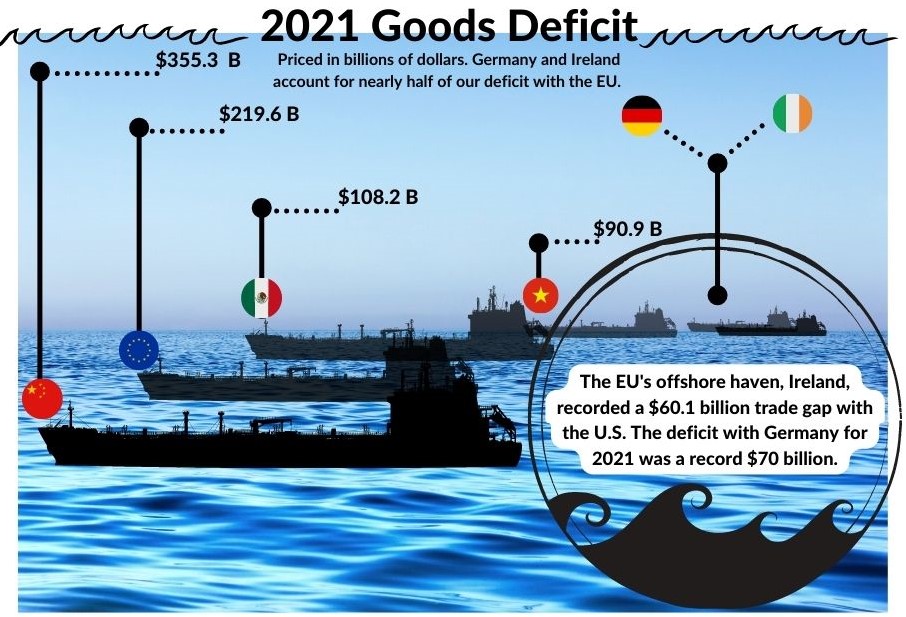The U.S. goods trade deficit was $1.09 trillion in 2021, a record-breaker by any measure. No country in the world has ever had a deficit that large in terms of value and in volume. To put that into perspective, the Mexican economy in 2020, the most recent year for World Bank data, produced $1.07 trillion in GDP.
The Bureau of Economic Analysis released its year-end and December trade figures on Tuesday, showing the ongoing trend of import growth as the U.S. spent much of 2021 bouncing back from government-forced lockdowns of small and mid-sized businesses.
Despite tariffs making it more expensive to import goods from China, the U.S.-China trade deficit ended 2021 higher than pre-pandemic 2019, coming in at $355 billion. In 2019, the trade gap with China was $344.3 billion.
The China deficit is not a record-breaker, however, as tariffs have shifted supply chains into southeast Asia. This has been especially true for solar and furniture manufacturing in low cost, weak currency nations like Vietnam. The trade deficit with Vietnam hit a record breaking $90.9 billion, double where it was in 2018 when the Trump administration began imposing tariffs on mainland China imports.
A more interesting number is the massive deficit with the rich European Union It’s approaching China-levels and is twice that of the Mexico trade deficit. The U.S. trade gap with EU nations hit $219.6 billion last year, up from $184.2 billion in 2020, which was the last record. Most of this is Germany and Ireland pharmaceuticals and automotive parts imports.
 “Our huge trade deficit is a trillion-dollar missed opportunity,” said Jeff Ferry, chief economist for CPA. “The huge volume of imports and the record-breaking trade and goods deficits are evidence that the U.S. economy is failing to generate domestic production and growth on a scale anywhere near the demand that U.S. consumers demonstrated in 2021. It is urgent that government policy address these challenges now. A set of policies is needed to reverse the deficit. No single policy can do it.”
“Our huge trade deficit is a trillion-dollar missed opportunity,” said Jeff Ferry, chief economist for CPA. “The huge volume of imports and the record-breaking trade and goods deficits are evidence that the U.S. economy is failing to generate domestic production and growth on a scale anywhere near the demand that U.S. consumers demonstrated in 2021. It is urgent that government policy address these challenges now. A set of policies is needed to reverse the deficit. No single policy can do it.”
For 2021, the goods and services deficit increased by $182.4 billion, or 27%, from 2020. Exports increased by $394.1 billion, or 18.5% for a total of $2.52 trillion exported. Imports increased by 20% or $576.5 billion over 2020 to hit a goods and services import total of $3.38 trillion.
Strong Dollar Makes it Easy
The trade deficit can also be blamed on a strong dollar. Tariffs are not enough to stem the tide. A strong dollar not only makes it cheaper to source goods from countries where the currency is heavily discounted, but it also makes more business sense to invest in factories or outsource manufacturing.
Something has to be done to rein in the dollar or the 2022 deficit will hit $1.2 trillion.
A new CPA study, released on Tuesday, shows that for the world’s major economies to achieve fair currency values and eliminate global imbalances, large adjustments in major currencies would be required. The dollar would need to fall by 16.6%, while the Chinese yuan would need to rise against the dollar by 21.7%, the Japanese yen by 40.2%, the Euro by 27.3%, and the Korean won by 31.3%.
“The study shows that currency misalignment is a huge disadvantage for nations saddled with overvalued currencies like the U.S.,” said Ferry.
The persistent misalignment of the dollar has made the U.S. economy less globally competitive and worsened income inequality. Current policy efforts aimed at rebuilding supply chains, while worthwhile, face substantial headwinds if dollar overvaluation is not addressed.
December Deficit: Who’s Buying What?
The overall goods and services deficit was $80.7 billion in December, up $1.4 billion from $79.3 billion in November. The goods deficit for the month was $101.4 billion, based on exports of $158.2 billion and imports worth $259.6 billion. Imports for the month smashed December 2019 records of $205 billion.
Our deficits with Asia increased in December.
- The deficit with China increased $6.0 billion to $34.1 billion. Exports decreased $2.2 billion to $11.8 billion and imports increased $3.8 billion to $45.9 billion.
- The deficit with South Korea increased $1.4 billion to $3.7 billion in December. Exports decreased $0.9 billion to $4.8 billion and imports increased $0.5 billion to $8.5 billion
Much of this was due to the Christmas holiday, with consumer goods imports for things like toys and phones rising more than $5 billion.
U.S. exports for the month were driven by, in order of value, cars and car parts (+$1.6 billion combined; nonmonetary gold (+$1.2 billion); pharmaceuticals (+$1 billion); capital goods (+$900 million) and aircraft engines (+$600 million).
U.S. imports for December were biggest among cars and car parts (+$2.4 billion combined); capital goods (+$2.3 billion); toys and sporting goods (+$1 billion); and household appliances (+$600 million).
All told for the year, the U.S. has proven itself to be a drugs and commodities exporter, with automotive bringing up the rear in fourth place. The pharmaceutical industry saw a boon in 2020 due to the pandemic. However, the global pharmaceuticals trade is one of the top five markets in the world, along with oil, electronic circuit boards and cars. The U.S. is one of the leaders in this space and is one area where reshoring critical medicines and other manufactured items in the medical supply chain should be an easy political decision for Congress when it comes to reshoring.
New Study: Global Currency Misalignment Challenges US Reindustrialization Efforts













